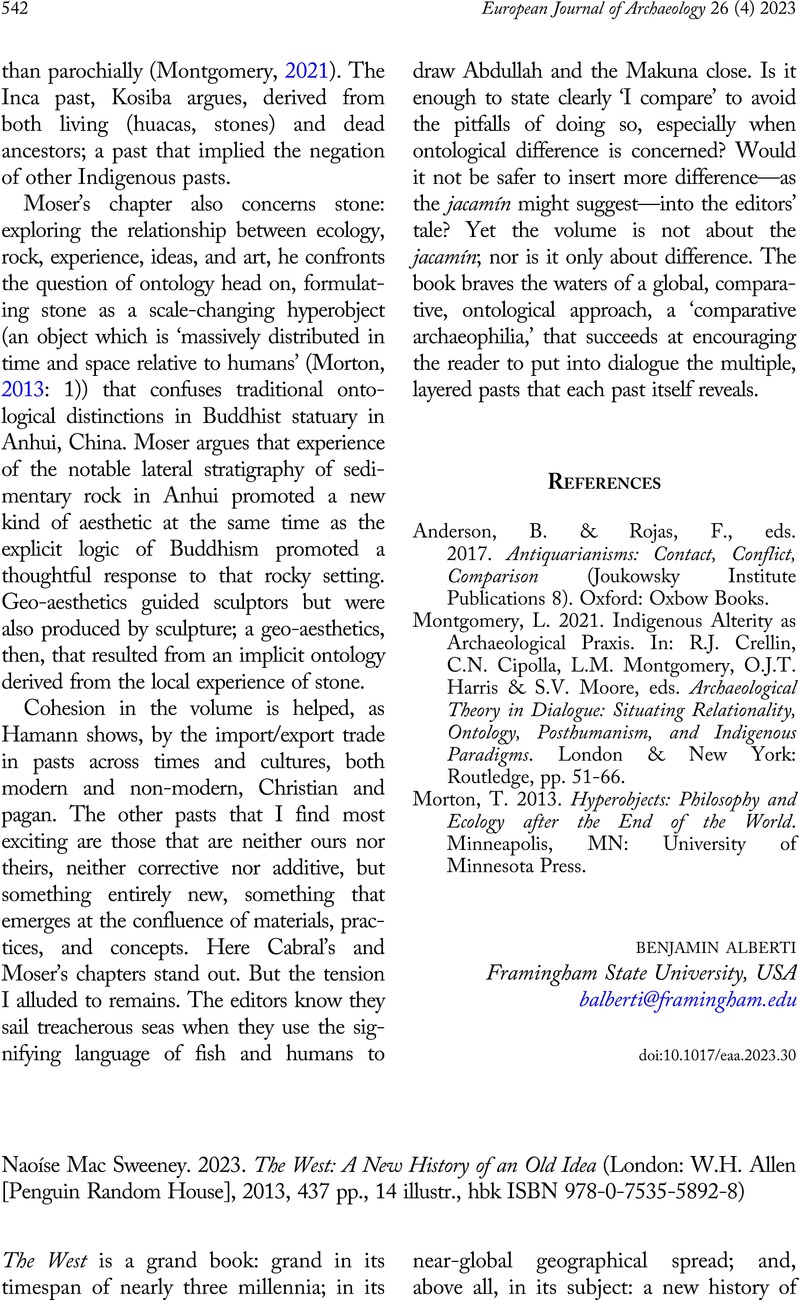No CrossRef data available.
Article contents
Naoíse Mac Sweeney. 2023. The West: A New History of an Old Idea (London: W.H. Allen [Penguin Random House], 2013, 437 pp., 14 illustr., hbk ISBN 978-0-7535-5892-8)
Review products
Naoíse Mac Sweeney. 2023. The West: A New History of an Old Idea (London: W.H. Allen [Penguin Random House], 2013, 437 pp., 14 illustr., hbk ISBN 978-0-7535-5892-8)
Published online by Cambridge University Press: 05 October 2023
Abstract
An abstract is not available for this content so a preview has been provided. Please use the Get access link above for information on how to access this content.

- Type
- Book Review
- Information
- Copyright
- Copyright © The Author(s), 2023. Published by Cambridge University Press on behalf of the European Association of Archaeologists
References
Abd el Gawad, H. and Stevenson, A. 2021. The Social Justice of Recognition: Confronting Histories of Injustice in Egyptian Archaeology through Egypt's Dispersed Heritage. In: W. Carruthers, ed., Special Issue: Inequality and Race in the Histories of Archaeology, Bulletin of the History of Archaeology, 31(1): 4, pp. 1–19. doi: https://doi.org/10.5334/bha-660CrossRefGoogle Scholar
Ancient Civilizations Forum, n.d. Available at https://ancientcivilizationsforum.org/ [accessed 23 August 2023]Google Scholar
Bond, S. 2017. Whitewashing Ancient Statues: Whiteness, Racism and Color in the Ancient World [accessed 17 July 2023]. Available at: https://www.forbes.com/sites/drsarahbond/2017/04/27/whitewashing-ancient-statues-whiteness-racism-and-color-in-the-ancient-world/Google Scholar
Gladstone, W. 1880. Preface. In: Schliemann, H., Mycenae: A Narrative of Researches and Discoveries at Mycenae and Tiryns. New York: Scribner, pp. v–xl.Google Scholar
Herrin, J. 2020. Ravenna: Capital of Empire, Crucible of Europe. London: Allen Lane/ Penguin Random House.CrossRefGoogle Scholar
Higgins, C. 2017. Mary Beard is right – ‘Romans’ could be from anywhere, from Carlisle to Cairo [accessed 17 July 2023]. Available at: https://www.theguardian.com/world/shortcuts/2017/aug/07/mary-beard-romans-ancient-evidenceGoogle Scholar
Kennedy, R.F. 2020. Defining Race and Ethnicity in Ancient History, in the series The Study of Antiquity and the Middle Ages [online] 12 October 2020 [accessed 23 July 2023]. Available at: https://www.youtube.com/watch?v=r8eD2CkVlGwGoogle Scholar
Morgan, E. 1877. Ancient Society Or Researches in the Lines of Human Progress from Savagery through Barbarism to Civilization. London: Macmillan.Google Scholar
Nixon, L. 2004. Chronologies of Desire and the Uses of Monuments: Eflatunpınar to Çatalhöyük and Beyond. In: D. Shankland, ed., Anthropology, Archaeology and Heritage in the Balkans and Anatolia or The Life and Times of F.W. Hasluck (1878–1920), Istanbul: Isis, pp. 99–118. Also available at http://tinyurl.com/q087mcGoogle Scholar
Nixon, L. 2020. Messages from Mykene: Othering and Smothering. Intersectional Orientalism and Sexism in a Museum Exhibition. Everyday Orientalism blogpost [accessed 21 July 2020]. Available at https://everydayorientalism.wordpress.com/2020/07/08/messages-from-mykene-othering-and-smothering-intersectional-orientalism-and-sexism-in-a-museum-exhibition/Google Scholar
Royal Geographic Society n.d., The Global North/South Divide. Available at https://www.rgs.org/CMSPages/GetFile.aspx?nodeguid=9c1ce781-9117-4741-af0a-a6a8b75f32b4&lang=en-GB#:~:text=In%20the%201980s%2C%20the%20Brandt,of%20Australia%20and%20New%20Zealand. [accessed 23 August 2023]Google Scholar


